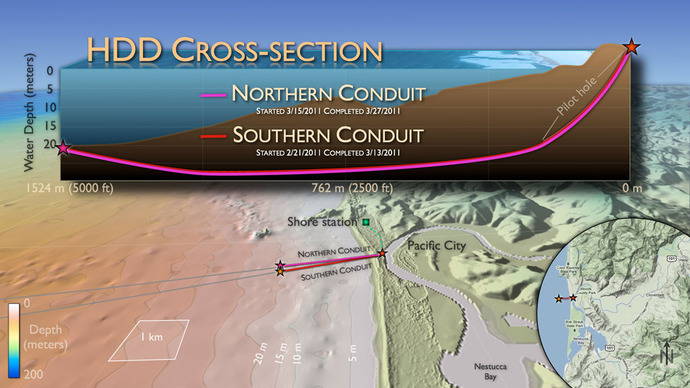The first installation phase of the Ocean Observatories Initiative's Regional Scale Nodes officially began on February 7, 2011, with preparatory work near the shore station in Pacific City, Oregon. Equipment was set up to begin drilling two conduits through which the submarine cables will be pulled ashore in summer 2011.
Drilling of the two 5,000-foot horizontal conduits began on February 21, 2011 using horizontal directional drilling (HDD). HDD is a common technique used to install cables, pipelines, fiber-optic ducts, and other types of buried infrastructure. Each conduit will be 5 inches in diameter and will stretch from an existing beach manhole, under the dune, beach, and seabed to a position offshore at a water depth of about 60 feet (20 meters). The conduits will protect the cables in the surf zone, thereby reducing maintenance activities close to shore throughout the planned 25-year lifetime of the system.
The southern conduit will be used for the OOI cable to the Hydrate Ridge study site and the Endurance Array; the northern conduit will be used for the cable to the Axial Seamount site. Drilling is expected to take 60 to 80 days depending on soil conditions encountered. Location of the conduits are shown on the illustration included here. Drilling and installation of casing was completed two weeks ahead of schedule on March 28, 2011. The cables are scheduled to be pulled ashore from a commercial cable-laying vessel in July 2011.
Pacific City was selected for the OOI cable landing because infrastructure originally built for the North Pacific Cable, including a Shore facility, was already in place. Two OOI employees reside in the area and manage the Shore Station. As the organization responsible for construction and development of the OOI cabled network, the University of Washington (UW) contracted with L3 Maripro Inc. (L3) for the design and build of the primary infrastructure. Throughout drilling operations, representatives of L3 and the University of Washington were on site to monitor working conditions and to ensure that the best level of performance and safety standards were achieved.
The construction blog covered drilling activities.
For more information and photos, see here.



